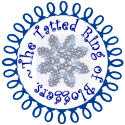I used contrasting threads in size 20 for these samples. Each length is made up of chains. Start out with ch ds 8, then flip over and ch ds 8 of the other color. The shuttle is still attached to the ball in each case. Then you take the 2 shuttles together and ch 1 ds of one color and then flip over and do the same with the other color, still using the 2 shuttles together. The entire length is chain stitch.

This is one length in progress.

Here are two lengths complete. You then place one on top of the other.
Pull the bottom length through the top loop or opening. Then pull the bottom loop through the next top one. Continue to do that all the way down, always pulling the bottom up through the top.

In this case, I kept the two colors opposite when they were laid one on top of the other and this is the result. It looks the same on the back side.

I took the one above apart and then laid them so the same color was on each side and went through the pulling up process again. Of course, if you used a single color, it wouldn't matter.
The 2 stitches using the 2 shuttles as one between sections of ch 8 ds is called pearl tatting here. Jean comments that you can change the effect by making that section longer - using 4 stitches for instance instead of 2. You could also alternate the colors during the tatting by switching ball threads, adding picots, or even using 4 different colors.
This makes a nice flat braid, a substantial cord. It's not very flexible however, so you wouldn't want to use it on the edge of anything curved unless it was a wide curve. It will curve but not as readily as the split chain plait. This was the first of 3 methods. I used the 3rd method for the butterfly necklace, but this probably would have gone faster. I don't think I could have added beads with the same effect however.
After this, I'm going to try the second method which is really a combination of this one and the third. It's 2 lengths like this, except the lengths are each split rings, and they are put together the same way this one is. In this case, Jean says the appearance is different on each side. I suspect the split rings will be somewhat more rigid than the chains and possibly more difficult to pull through.














































%2B(650x228).jpg)

















































































































.JPG)
























0 comments:
Post a Comment
Emails and comments both are welcome and always read.